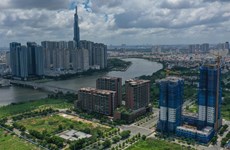Opportunities to reach largest Trans-Pacific partners: officials
When the Trans-Pacific Partnership (TPP) is put into place, Vietnam
will benefit from its position as a TPP member, and the country’s
garment and textile is expected to benefit a lot. However, the deal
offers both good opportunities and challenges. Insight from Vietnam
Business Forum.
When the Trans-Pacific Partnership (TPP) is put into place, Vietnam
will benefit from its position as a TPP member, and the country’s
garment and textile is expected to benefit a lot. However, the deal
offers both good opportunities and challenges. Insight from Vietnam
Business Forum.
Through negotiations of the Trans-Pacific Partnership (TPP), the participating countries have reached a preliminary agreement on many important issues such as tariff reductions, textiles, services and investment liberalisation. For Vietnam, the TPP offers both good opportunities and challenges.
This was a conclusion of the conference "Agreement on Trans-Pacific Partnership and the participation of Vietnam" held recently by the Ministry of Industry and Trade in cooperation with the Vietnam Chamber of Commerce and Industry (VCCI).
Negotiation in progress
Minister of Industry and Trade Vu Huy Hoang said: "Agreement on the Trans-Pacific Partnership (TPP) is a high-standard free trade agreement (FTA), regarded as a model treaty of the 21st century."
The TPP currently has 12 members including Brunei, Canada, Chile, the US, Malaysia, Mexico, Japan, New Zealand, Australia, Peru, Singapore and Vietnam.
Tran Quoc Khanh, Deputy Minister of Industry and Trade, chief begotiator for the TPP, said the TPP has conducted 19 formal sessions and multiple mid-sessions, including two ministerial sessions. Ministerial negotiations will take place in Singapore early next month.
According to the statement of the TPP's leaders at a meeting on the sidelines of the APEC summit, held in Indonesia from October 3 to October 8, the TPP countries are trying their best to promote the basic negotiations to finish the negotiations at the end of 2013.
Deputy Minister Khanh said: "Through the negotiations, the participating countries have reached a preliminary agreement on several important issues such as tariff cuts, textiles, liberalisation of services and investment, government procurement, and intellectual property."
Besides, nearly 20 other areas in the progress of negotiations include the issues related to the open markets for goods, rules of origins, TBT, SPS, provisions of the cross-border services, financial services, e-commerce, investment, intellectual property, government procurement, labour, environment, and state-owned enterprises, etc.
Advantages and disadvantages
"Participation in TPP would help Vietnam improve export markets structure, open more markets for Vietnamese goods, participate in regional and international production chains, facilitate the economic restructuring and innovate the growth, improve the institutional environment and increase the attractiveness of the foreign and domestic investment, create new production capacity as well as jobs for workers," said Khanh.
The TPP aims to eliminate 100 percent import duty, of which 90 percent will be removed immediately once the agreement takes effect. The opportunities to increase exports and competitive advantages of Vietnamese goods in major markets such as the US or Japan will be bigger.
Le Tien Truong, Vice President of the Vietnam Textile and Apparel Association (VITAS) cum Deputy General Director of Vietnam Textile and Garment Group, also pointed out the advantages this industry will gain after joining TPP.
Among the 16,000 tariff lines in the HS 8 digits, the textile imported to the US market is regulated under Chapters 50 to 63 and Vietnam has exported to the US with approximately 1,000 tariff lines at the average MFN tax of 17-18 percent. The TPP is expected to cut tariffs gradually to 0 percent.
According to the calculation, textile exports from Vietnam to the US could grow by 13 percent to 20 percent per year in the period 2013 to 2017 and may reach from 25 billion USD to 30 billion USD in 2025.
However, Truong also said the TPP will provide both good opportunities and challenges. The challenges may relate to the rules of 'yarn forward' origin, tax cuts and the lower competitiveness of the textile industry of Vietnam.
Experts also pointed out a number of industries in Vietnam, which will certainly have difficulties joining the TPP. Among those areas, we could list some such as agricultural products, livestock related to chicken, pork, and beef industry, which are known as the advantages of Australia and the US. Besides, Vietnam's automobile industry will face difficulties when the country fully opens its market to the US, Japan and some developed markets.-VNA
Through negotiations of the Trans-Pacific Partnership (TPP), the participating countries have reached a preliminary agreement on many important issues such as tariff reductions, textiles, services and investment liberalisation. For Vietnam, the TPP offers both good opportunities and challenges.
This was a conclusion of the conference "Agreement on Trans-Pacific Partnership and the participation of Vietnam" held recently by the Ministry of Industry and Trade in cooperation with the Vietnam Chamber of Commerce and Industry (VCCI).
Negotiation in progress
Minister of Industry and Trade Vu Huy Hoang said: "Agreement on the Trans-Pacific Partnership (TPP) is a high-standard free trade agreement (FTA), regarded as a model treaty of the 21st century."
The TPP currently has 12 members including Brunei, Canada, Chile, the US, Malaysia, Mexico, Japan, New Zealand, Australia, Peru, Singapore and Vietnam.
Tran Quoc Khanh, Deputy Minister of Industry and Trade, chief begotiator for the TPP, said the TPP has conducted 19 formal sessions and multiple mid-sessions, including two ministerial sessions. Ministerial negotiations will take place in Singapore early next month.
According to the statement of the TPP's leaders at a meeting on the sidelines of the APEC summit, held in Indonesia from October 3 to October 8, the TPP countries are trying their best to promote the basic negotiations to finish the negotiations at the end of 2013.
Deputy Minister Khanh said: "Through the negotiations, the participating countries have reached a preliminary agreement on several important issues such as tariff cuts, textiles, liberalisation of services and investment, government procurement, and intellectual property."
Besides, nearly 20 other areas in the progress of negotiations include the issues related to the open markets for goods, rules of origins, TBT, SPS, provisions of the cross-border services, financial services, e-commerce, investment, intellectual property, government procurement, labour, environment, and state-owned enterprises, etc.
Advantages and disadvantages
"Participation in TPP would help Vietnam improve export markets structure, open more markets for Vietnamese goods, participate in regional and international production chains, facilitate the economic restructuring and innovate the growth, improve the institutional environment and increase the attractiveness of the foreign and domestic investment, create new production capacity as well as jobs for workers," said Khanh.
The TPP aims to eliminate 100 percent import duty, of which 90 percent will be removed immediately once the agreement takes effect. The opportunities to increase exports and competitive advantages of Vietnamese goods in major markets such as the US or Japan will be bigger.
Le Tien Truong, Vice President of the Vietnam Textile and Apparel Association (VITAS) cum Deputy General Director of Vietnam Textile and Garment Group, also pointed out the advantages this industry will gain after joining TPP.
Among the 16,000 tariff lines in the HS 8 digits, the textile imported to the US market is regulated under Chapters 50 to 63 and Vietnam has exported to the US with approximately 1,000 tariff lines at the average MFN tax of 17-18 percent. The TPP is expected to cut tariffs gradually to 0 percent.
According to the calculation, textile exports from Vietnam to the US could grow by 13 percent to 20 percent per year in the period 2013 to 2017 and may reach from 25 billion USD to 30 billion USD in 2025.
However, Truong also said the TPP will provide both good opportunities and challenges. The challenges may relate to the rules of 'yarn forward' origin, tax cuts and the lower competitiveness of the textile industry of Vietnam.
Experts also pointed out a number of industries in Vietnam, which will certainly have difficulties joining the TPP. Among those areas, we could list some such as agricultural products, livestock related to chicken, pork, and beef industry, which are known as the advantages of Australia and the US. Besides, Vietnam's automobile industry will face difficulties when the country fully opens its market to the US, Japan and some developed markets.-VNA











